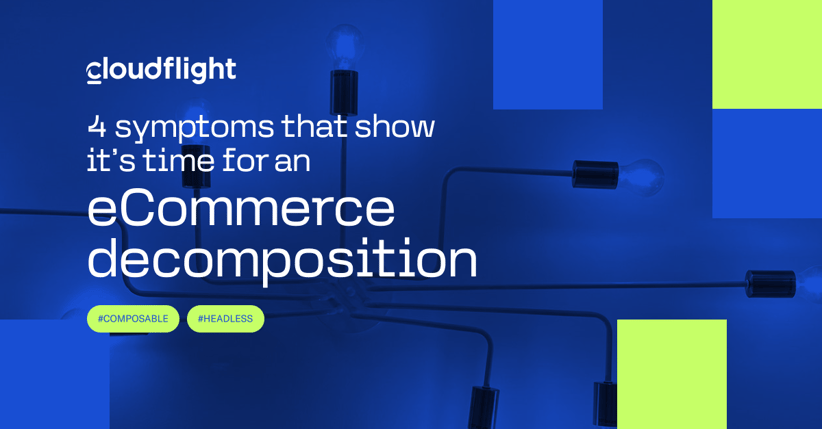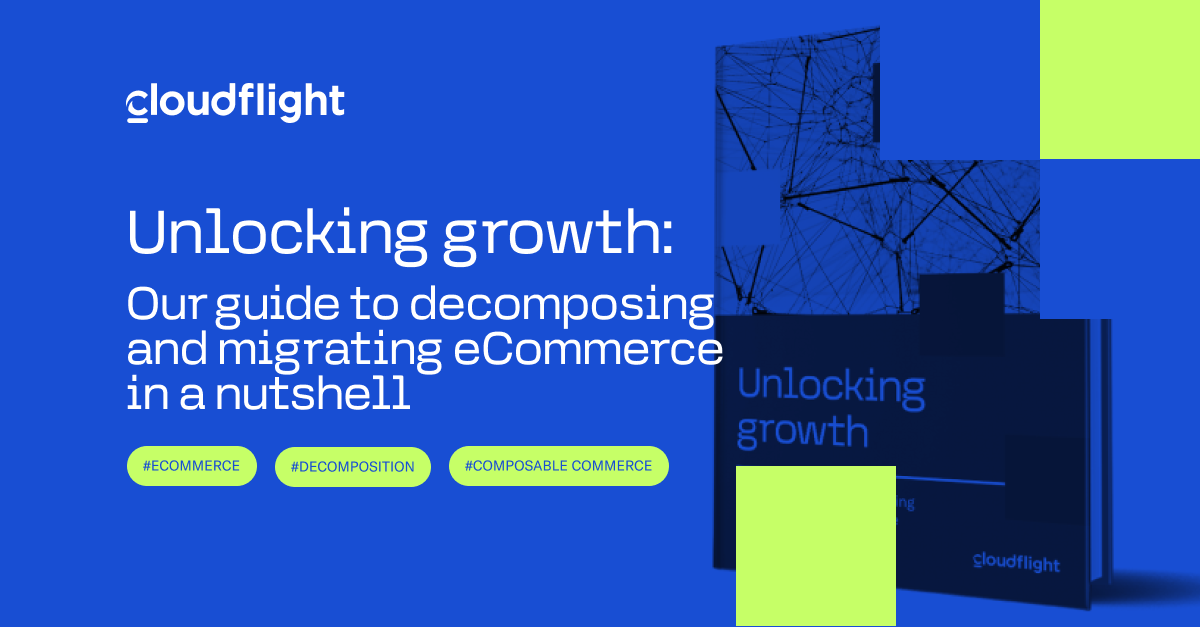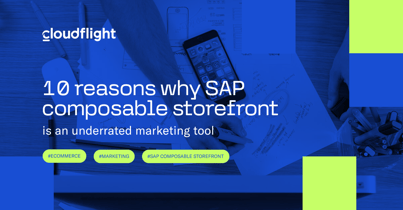In the rapidly evolving world of eCommerce, staying ahead of the competition requires businesses to quickly adapt to changing market dynamics. One strategic approach to achieving this agility that’s quickly picking up steam in the industry is through the process of decomposition.
A few weeks ago, we published an article that went over the initial steps that you should take if you’ve decided to pursue a decomposition process. You can consider this one as a prequel of sorts. Today, we’ll take a look at an earlier stage of this process and consider a few common symptoms that suggest it’s time to start thinking about decomposition in the first place. So, if you’re on the verge of such a decision or have been worrying about your eCommerce system’s health recently, this article is very much for you.
1. Scalability issues
The most common sign that it might be high time for a decomposition treatment for your eCommerce platform comes up when your business starts to experience scalability issues. When your brand gains popularity and customer engagement increases, the existing architecture might struggle to accommodate the increased traffic, orders, and transactions. It doesn’t collapse in a spectacular way, but you notice that it runs out of breath every now and then, making your customers wait for it to catch up. Both the front end and the back end might start to slow down, resulting in increased loading time or even producing errors that you haven’t experienced before.
This happens because monolithic solutions are generally quite poor at resource distribution. Even if you upgrade the hardware they’re running on as the business needs increase, they’ll allocate the extra resources according to their set-in-stone rules rather than the real fluctuating needs.
The first symptoms of scalability issues
Performance bottlenecks can hinder user experience and lead to lost sales opportunities. At this point, most eCommerce owners are familiar with the research on how increased load speeds lead to lost conversions, but bringing up common knowledge doesn’t make it any less true. When your load speed falls to three to four seconds, it’s a clear sign that your architecture is having issues. More egregious technical problems, such as errors or total site crashes, will be even more of a turn-off for your visitors. It’s not only a matter of convenience but also of the credibility of your store and brand being at stake.
Image source: Portent
How composable architecture improves scalability
Depending on your unique implementation, some of those issues in monolithic systems can be temporarily fixed with updates or other more or less complicated tweaks. But it’s just putting band-aids on a wound that needs stitches to heal properly. In the long run, a complete system overhaul is the only way forward. Simply put, those systems aren’t built for the tasks you might expect them to handle as your business keeps growing.
Decomposition addresses this problem by distributing the workload across smaller, interconnected API-based services held together by a central eCommerce engine. This kind of therapy is called horizontal scaling. It means that instead of adding more and more power and resources to a single monolith, which is the vertical approach, you’re adding multiple smaller systems and scaling them individually.
It’s a composable eCommerce spin on the power of agility. The separate systems aren’t hugely powerful on their own, but when each of them is delegated to specific tasks, together they become more capable of handling challenges than a monolith would be. When one of them, for instance, the product information management (PIM) module, stops being sufficient, you’re only adding resources to this precise part of your ecosystem and not the entire massive thing. The extra resources, in turn, can be spent and used in their entirety to improve this one specific system.
2. Difficult maintenance
When you first started using your monolithic eCommerce system, you were probably impressed with how well all the different features complement one another. They came together into a cohesive whole: a well-oiled machine straight out of the box. But then, as you started tweaking with the ecosystem, month by month you started to notice the other side of the coin.
Implementing changes started to take more and more of your developers’ time and bugs started to pop up every now and then, which, together, resulted in a longer time to market. Because the features are so tightly coupled together, working on one of them often means having to adjust all the others as well. This brings about more and more problems with every tweak you make within the system.
Common symptoms of high coupling syndrome
This domino effect is normal with monolithic ecosystems. It’s a symptom that, in our professional eCommerce doctor circles, we refer to as “high coupling.” As your eCommerce business and the monolithic platform that supports it grows, so does its codebase. You become entangled in a spaghetti of complicated interdependent systems, and it gets more and more challenging to make sense of them in terms of maintenance and development.
Your developers’ jobs get harder with every new feature added to the system. It becomes difficult to introduce changes, and the risk of things going awry with bugs and unexpected behavior increases. Simply put, there comes a time when you and your technical staff start dreading new features being added and upgraded in a monolithic system rather than be excited with the opportunities they present.
Untangling spaghetti code with the decomposition process
This is another clear sign that it’s time to make radical changes to your eCommerce infrastructure. The prescribed treatment, which is the process of decomposition, breaks the tangled monolith into smaller, easily manageable pieces that you can easily work on individually. Since the only way they’re connected is through the API, there’s no need to worry that modifying one piece will somehow trigger a domino effect that breaks other ones.
Switching to a composable architecture makes the development and maintenance of your eCommerce infrastructure simpler for all parties involved. Its effects are probably felt the most when it comes to your bottom line because the whole development process becomes cheaper and less time-consuming.
You save time and, by extension, money on each of the necessary stages that go into this kind of project: planning, development, testing, release, and user training. When you’re making updates, you no longer need to update the whole system at once; you can now work on the systems individually, one by one as the need emerges. It’s as if you’re replacing expensive physiotherapy with simply swimming every now and then.
3. No room for innovation
In the dynamic landscape of modern eCommerce, the ability to quickly adapt to changing needs and innovate is what can put you in front of your competitors. When you were growing your business, implementing a monolithic system was probably a huge leap forward. Like learning to walk, the multitude of different features suddenly opened up many new possibilities. But the honeymoon period doesn’t last forever. As your eCommerce business matures, you start to take the features of your monolith for granted while your needs keep growing.
Sadly, it’s often the case that the development of monolithic systems doesn’t keep up with your increasing needs. Because of how complex and interlocked they are, new features tend to get introduced very slowly. Each new release goes through a lengthy process of decision-making, planning, development, and, above all else, testing to ensure it doesn’t break the whole delicate structure. You’re ready to run and jump, but your system is still just at the walking stage. The process is also nearly completely outside of your control. Depending on the system you’re running, your in-house developers might be able to accomplish some degree of customization, but it’s unlikely they’ll be able to implement major features.
All of the above come together into the next set of symptoms. Your monolith becomes slow to respond to changing market needs and holds you back by limiting your ability to innovate. In other words, there comes a point where the system becomes more of an obstacle than a tool that once supported your business growth.
How composable eCommerce improves time to market
The way composable architecture solves this issue is quite similar to the mechanisms from the previous point about efficiently scaling up. When you’re running an API-based infrastructure, adding new features or even whole systems is entirely up to you. On top of that, it also becomes a much quicker, easier process. You’re not working on the whole ecosystem at once; now you’re just implementing new features one by one as you see fit and at your own pace. It’s a strategic shift towards agility and innovation.
Flexible API connections bring a huge advantage over the set-in-stone “high coupling” approach found in monoliths. If something goes wrong, the worst-case scenario is that the newly introduced system won’t work properly. That’s it. You’re not risking the entire thing going up in flames as is the case with monolithic systems. This opens up avenues to experiment, innovate, and quickly test new approaches and discard them if needed without any negative consequences. The process of decomposition can make your business more responsive to market shifts and, in the long run, position you as a leader in your niche.
4. Lack of omnichannel support
You must have heard about the omnichannel approach being the next big thing in eCommerce. It’s what all the big players are doing, and not without a reason; implementing this approach has proven to increase revenue by a significant margin. Sadly, this might be out of your reach if you’re running a monolithic architecture. Like painful, unexercised joints, sticking with a monolith can severely limit your business agility and might mean you have to give up on certain opportunities.
But what exactly does “omnichannel” mean in the first place, and why is it so important? The term is often used as a buzzword without much consideration, so let’s spend a minute digging into it. The concept popped up as a response to the diversification of consumer touchpoints. Customers now interact with brands and stores across a wide range of platforms: from websites and mobile apps to social media, marketplaces, and emerging tech like voice assistants. Naturally, you want to establish a presence on as many of those touchpoints as possible so you don’t miss out on any opportunities.
Pains of going omnichannel with a monolith
Here’s the catch; if you’re running an eCommerce setup based on a monolith, managing all those channels at once takes a lot of work. First, you need to set them up one by one and then manually keep them in sync at all times to ensure consistency in branding and product information. That’s without even mentioning adjusting data for specific requirements of each channel, which is a whole different, complicated process in itself. Your monolith isn’t much help here; it’s built to support its dedicated web front end and nothing else. All other connections will have to be forced in one way or another.
All in all, you’ll either end up with enough work for an entire team or will need to let go of most of the opportunities presented by the omnichannel approach. The integration of new channels and interfaces into monolithic systems, if even possible in the first place, will be difficult, painfully slow, and plagued with unexpected problems. This will lead to another set of symptoms: chaotic customer experience, low operational efficiency, and missed opportunities to engage with your clients.
Seamless omnichannel transition with composable architecture
The treatment for this disappointing condition is once again the process of eCommerce decomposition. While a monolithic system is like a smartphone with its single dedicated, tightly coupled screen, headless architecture is like a home gaming console. You can plug it into any TV or monitor and probably even your smart fridge screen if you’re stubborn enough, and it will work just fine straight out of the box. If you want to plug it into all of them at once, it’s not a problem either. The API that connects them works like an infinite splitter for the HDMI port.
Image source: Codal
With the composable approach, the process of going omnichannel is easy in both the technical and business sense. Those systems are built from the ground up with the idea of connecting to anything and everything, meaning that you have many specialized tools at your disposal to make it as seamless as possible. For instance, Akeneo, a headless PIM solution, lets you set up product info in such a way that different descriptions and attributes are automatically fed to specific channels. All of that still happens within a single centralized system and product entry with no need to manually migrate anything.
Final diagnosis and treatment
If the symptoms mentioned in this article sound familiar to you, it might mean it’s time to become interested in your eCommerce system’s health. While the advantages of monolithic infrastructures can’t be denied, there comes a point when they start being outweighed by the problems and limitations listed above. Depending on the unique needs of your business, you’ve either already reached this point, or you will eventually.
Moving toward a composable architecture is a safe and proven treatment. It’s a quality of life improvement in some of the aspects, but, most importantly, it also opens up completely new possibilities to develop your business further. It doesn’t have to be a complete, all-at-once overhaul. As described in our article about decomposition, the process can happen gradually to best suit your needs. Composable commerce offers almost endless viable paths forward, so make sure to get in touch, and let’s develop the best one for you together.
Published September 6, 2023











